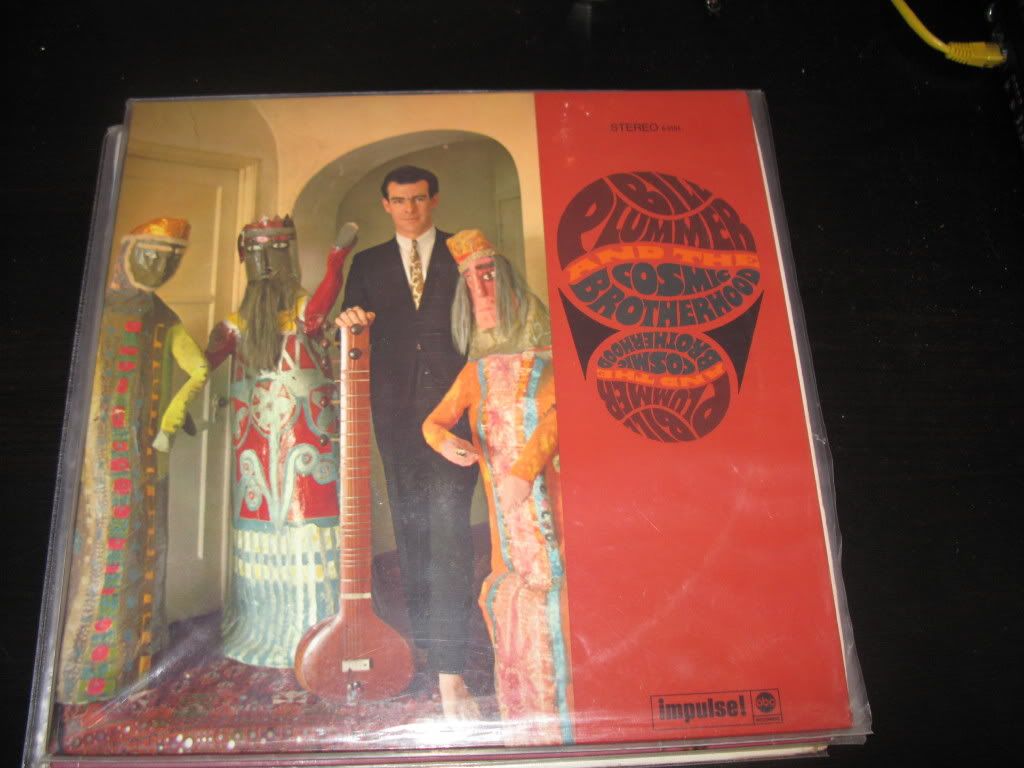I like sitar-jazz records. There is something about the collision of two disparate forms of music that intrigues me, as it no doubt intrigued those who made them.
As far as I can gather traditional sitar playing does not have room for improvisation. It is built up of layers of cyclical playing, ragas, that can be as forumlaic as western classical music.
This record was released in 1968 while the John Mayer/Joe Harriot Indo-Jazz Fusions record came out in 1965. As such it was not a ground-breaking record.
It also differs from the Harriot/Mayer record in that none of the musicians are from India. As such this is not so much a meeting of two different musical cultures but more the use of a set of musical devices and instruments by a group of jazz trained musicians.
And there is nothing wrong with that. It does, however, mean that the music is in danger of veering into exotica or even exploitation territory. I love both of these styles of music so I'm not too bothered. However, as much as the linear notes try and persuade you otherwise this record is a blatant attempt to cash in on America's increasing interest in the 'east'.
The 'east' in the western imagination has stood for a large number of things and in the sixties it came to be seen as place of spiritual enlightenment. A place to escape the horrors of western capitalism and the mechanised, ordered world, a place where people could find out who they were. The Beatles' sojourn with the Maharishi was very influential.
The 'east' also came to be connected with a kind of drugged out bliss. The music that westerners associated with this was often the sitar. It was strange and exotic and is floated and swirled rather than pummeled and attacked as so much western music seemed to do. The repetitive nature of ragas also helped stoned people to reach bliss.
There is very much a soundtrack flavour to the Comic Brotherhood. A feeling that a mood is being evoked by people who really don't know too much about it. The presence of studio session bassist supreme and member of the Wrecking Crew Carol Kaye does nothing to make me think otherwise.
At this time there were lots of these kind of records being put out whether they were sitar-sploitation such as the Folkswingers,freak-out exploitation such as the The Zodiac Cosmic Sounds or Emil Richards' New Time Elements. Wonderful records all but surely the produce of men trying to appeal to an audience they didn't really understand
Take Arr 294 on the second side. To my ears it sounds like the kind of 'freak out' track that you might hear in a Davie Allan soundtrack - although with added sitar.
The opening track, Journey to the East, is a poem set to music by Hersh Hamel who would go on to spend time with Art Pepper. It's repeated verse "Peace/ Is What I/ Had Come Searching For/ Spiritual Comfort/ Thoughts far/ From Those of War" I think neatly sums up what the 'east' stood for. Backed by some fine sitar playing this is one of the highlights of the record for me.
There are also two covers, The Look of Love and Lady Friend, the later being a Byrds track by David Crosby. Bob Thiele, who produced this record and ran Impluse, was always searching for pop-jazz hits. Although his label put out many records by 'new thing' artists such as Coltrane, Shepp, Ayler and re-released records by Sun Ra, he also put out a lot of easier and smoother records.
In my opinion the musicians seem most at home on these covers, no doubt because they were familiar and because they are basically jazz versions of the songs with sitar on top.
I got this record from an ebay sale. There used to be a web site called Show and Tell Music who, a few years ago, sold some of his collection in large batches. If I'd had any more money at the time I would have bought more but as it was I was very pleased to get the records I did. If you are out there and read this, please update your website - it was great.

No comments:
Post a Comment